Category Archives: Recipes
Happy Holidays! With Thanksgiving just around the corner, wow your guests with this unique and delicious twist on traditional apple pie. The rich sour cream center brightens the apple flavor and the presentation can’t be beat. For those with a dairy allergy replace the sour cream with soy sour cream or coconut yogurt. This can be made egg-free, too.
Apple Custard Crumb Pie 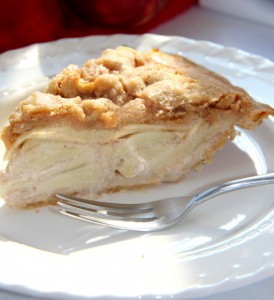
Serves 8
Streusel Topping
½ cup packed light brown sugar
¾ cup all-purpose flour blend (any brand)
½ teaspoon ground cinnamon
¼ teaspoon salt
6 tablespoons cold unsalted butter or dairy-free butter replacement, cut into small pieces
Filling
5 McIntosh apples
2/3 cup low-fat sour cream, dairy-free sour cream or coconut yogurt
1 large egg, lightly beaten
½–¾ cup sugar, to taste
3 tablespoons all-purpose flour blend of choice or rice flour
1 teaspoon ground cinnamon
¼ teaspoon salt
1 Flaky Pie Crust, uncooked (below)
1. To make Streusel Topping, combine all topping ingredients in a food processor and pulse until mixture resembles coarse meal. Reserve.
2. Preheat oven to 350°F.
3. Peel and thinly slice apples.
4. In a large mixing bowl, combine sour cream and egg and beat well.
5. In another bowl, combine sugar, flour, cinnamon and salt. Whisk into sour cream mixture. Add apple slices, tossing to coat.
6. Spread mixture over uncooked crust. Sprinkle Streusel Topping over the top.
7. Set pie on a cookie sheet for ease of handling. Place on middle rack in preheated oven and bake 55 to 60 minutes or until filling is bubbly and topping is brown. If crust browns too quickly, cover edges loosely with foil.
TIP: For an egg-free pie, replace the egg in the filling by adding 3 additional tablespoons sour cream (or dairy-free substitute) in step 4. Add 1 tablespoon cornstarch or potato starch in step 5.
Flaky Pie Crust
Makes One 9-Inch Crust
Unless rolled too thin, this dough is not prone to tearing. If it does, pull it back into place and pat it down.
1½ cups + 2 tablespoons High-Protein Flour Blend (below)
1 tablespoon potato flour (not potato starch)
1 teaspoon xanthan gum
¼ teaspoon salt
2-3 teaspoons sugar
½ teaspoon baking powder
½ teaspoon ground cinnamon
4 tablespoons cold butter or dairy-free butter replacement
4 tablespoons organic shortening
1 large egg or 2 tablespoons additional unsweetened applesauce
1 teaspoon cider vinegar
2 tablespoons unsweetened applesauce
1. In the bowl of a food processor fitted with the knife blade, combine dry ingredients. Cut buttery stick and shortening into pieces. Sprinkle over dry ingredients. Pulse several times until pieces are the size of large peas.
2. In a separate bowl, combine egg, vinegar and applesauce. Add to flour mixture and blend just to combine. Carefully gather dough into a ball. (Watch your fingers as steel knife is very sharp.) Wrap in plastic wrap and chill at least 1 hour.
3. Place the dough between 2 layers of plastic wrap and press it down with heel of hand. Then gently roll it into a 9-inch circle. Start from the middle and roll out uniformly in all directions to form the circle. Rotate the dough in ¼ turns to help even-out crust to about ¼-inch thickness throughout.
4. Carefully peel off the top layer of plastic wrap. Turn the crust into the pan, slowly peeling off the backing. Press the crust into the pan and crimp the edges, trimming off any excess dough.
TIP: To reduce the fat in this pie crust, replace 3 tablespoons butter or shortening with an equal amount of unsweetened applesauce.
High-Protein Flour Blend
Makes 3¼ cups
1 cup amaranth flour
1 cup brown rice flour
¾ cup cornstarch or potato starch (not potato flour)
½ cup tapioca starch/flour
1. Combine ingredients. Store in a tightly covered container in the refrigerator until used.
Short on time? Use a commercial high protein flour blend or add 1 cup of amaranth flour to 2 1/4 cups gluten-free all-purpose flour blend.
A version of this recipe first appeared in Living Without Magazine.
Categories: Recipes | Tags: gluten free apple custard pie, gluten free pie, gluten free Thanksgiving, gluten-free makeover, gluten-free recipes | 2 Comments »
In celebration of reaching 1,500 “Likes” on Facebook, I am sharing this collections of holiday recipes with all of you. Here’s to a happy, healthy, and tasty holiday season!
Categories: Recipes | Tags: gluten free, gluten-free holiday dishes, gluten-free recipes | 6 Comments »
Pear Coffee Cake
As a baker, I am reluctant to let go of certain sacrosacnt ingredients. Eggs is one of those precious commodities. Then a colleague who is gluten and egg-free asked me if I could convert a coffee cake recipe so she could enjoy, too. I recalled that, back in the days when I owned the Gluten-Free Pantry, I had made many recipes where I replaced eggs with silken tofu, flax gel (1 tablespoon flax meal with 3 tablespoons of hot water) or even with applesauce. I dug out my favorite coffee cake recipe, already gluten-free, and went to work. The results were delicious.
This stunning coffee cake uses soy (or coconut) yogurt and pear puree. The yogurt adds back some of the protein from the eggs and the pear puree, like applesauce, contains pectin which tenderizes the cake. I added a little bit more baking powder to help it rise, usually another job done by the eggs. 
This is comfort food at its best and begs for a cup of coffee or tea. I also like to make this with apples and applesauce.
1 cup sugar
1 ½ cups All-purpose Gluten-Free Flour Blend
½ cup sorghum flour
2 teaspoons xanthan gum*
½ teaspoon salt*
2 teaspoons baking powder
1 teaspoon baking soda
1½ cups soy or coconut yogurt (flavored yogurt works well)
6 tablespoons vegetable oil
4 tablespoons pureed baby pear puree or unsweetened applesauce
½ cup peeled and chopped ripe Bartlett, Bosc or red pears, or diced canned pears
Crumble Topping (below)
Preheat the oven to 325°F and lightly oil a 9-inch springform pan.
Combine the sugar, flour blend, sorghum flour, xanthan gum, salt, baking powder, and baking soda in a large bowl. Set aside.
Combine the yogurt, vegetable oil, and pear puree in a mixing bowl and beat until smooth. Add the dry ingredients and beat until smooth. Fold in chopped fruit.
Spoon half the batter over the bottom of the prepared pan and smooth to the edges of the pan. Cover with half of the crumb mixture. Spoon the remaining batter over the crumb topping and smooth to the edges. Sprinkle the remaining topping over the top.
Bake 50 to 55 minutes, until cake tester comes out clean and center springs back when gently touched.
Cool 10 minutes in the pan. Remove the rim of the pan and cool completely on a wire rack. Serve.
*If your all-purpose blend contains salt and gum, omit the salt and reduce the gum to ½ teaspoon.
Crumble Topping
½ cup rice flour
½ cup packed brown sugar
2 teaspoons ground cinnamon
¼ teaspoon ground allspice
1/8 teaspoon ground cloves
¼ teaspoon salt
4 tablespoons unsalted butter or non-dairy buttery spread, at room temperature
Combine the flour, brown sugar, cinnamon, allspice, cloves, and salt in a large bowl. Mix well. Add the butter and use fingertips or a fork to mix just until crumbly.
This can be made ahead and stored in the refrigerator for up to 2 weeks.
Categories: Recipes | Tags: baked goods, coffee cake, coffee cake recipes, comfort food, dairy-free, egg-free, gluten free, Sweets | 2 Comments »
Quick Chili Mac and Cheese
I think of myself as the champion of substitution. But truthfully, I hit a wall when asked to come up with a Macaroni and Cheese recipe recently. I hadn’t made Mac and Cheese since my son was a little boy. So many steps – – making a cream sauce, grating the cheese, cooking the pasta. Oh yes, the pasta. Gluten-free pasta always turned out gummy and mushy when I made it. And the final dish was too rich for my taste. So what was the incentive? Where was the payoff?
Then I came up with a few shortcuts. I replaced the cream sauce with hot chicken broth and added spicy Jack Cheese and let it melt – – cream sauce in seconds without the cream! For flavor, I cooked spicy chicken sausage, crumbled it and stirred in corn and green chilies.
But the big discovery came when I cooked the pasta only half as long as the instructions indicated. I finished this recipe by microwaving it and the pasta finished cooking while it absorbed some of the wonderful flavors of the sauce.
This recipe has become my favorite, my go-to quick meal during the cooler months. And the pasta holds together. No mush in this dish and no fuss, either. This is Mac and Cheese all grown up and it’s so delicious and easy to make, I wonder why I waited so long.
This versatile recipe tastes even better the second day. To add more fire, use the hottest sausage you can find. If you prefer a vegetarian version, omit the sausage or use a vegetarian sausage that’s safe for your diet.
3 cups (12 ounces) dried elbow pasta or 3-4 cups (8-10 ounces) other short pasta, uncooked
3-4 hot or mild chicken, turkey or pork sausages
1½ cups frozen corn
1 small can chopped green chilies
1 cup gluten-free, dairy-free chicken stock
2 teaspoons gluten-free Mexican or dairy-free Taco spice blend
2½ cups shredded spicy Jack Cheese or dairy-free cheese substitute, divided
Lightly oil a deep ovenproof dish (7½x11-inch, 9×13-inch, 9-inch round).
Cook pasta in salted water for half the time specified on package. Pasta should be undercooked (slightly opaque but not brittle). Drain and transfer to prepared baking dish.
While pasta is cooking, remove sausage from its casing and crumble into a well-oiled saucepan. Sauté meat until brown. Add corn and chilies, stirring to combine.
Using a wooden spoon, gently fold meat mixture into pasta.
Heat chicken stock in the saucepan until hot but not boiling. Add the spice blend and stir well. Remove from heat and add 2 cups grated cheese. Stir until smooth and pour over pasta. Gently toss to coat.
Top mixture with remaining cheese. Cover dish with moist paper towel and microwave on medium-high for 5 minutes or until bubbly. Enjoy.
Categories: Recipes | Tags: back to school meal in minutes, gluten-free meal in minutes, gluten-free pasta, macaroni and cheese | 1 Comment »
Crêpes were the first recipe I made over after I was diagnosed with celiac disease more than 35 years ago.
A few months earlier, I had been given Julia Child’s first cookbook, “Mastering The Art of French Cooking,” and I was cooking my way through Julia’s wonderful recipes. Her cookbooks opened a door and, whisk in hand, I went through. I cooked and baked and held parties just to have tasters who would help me devour my experiments. Her book was my beacon, my inspiration.
Then a doctor told me to avoid gluten and I was overwhelmed. I could not simply put those books back on the shelf and close my mind to the delicious foods I had discovered. So I went to culinary school and began experimenting again, but this time, I made my recipes with gluten-free flour. As long as I maintained the ratio in a recipe, the balance of wet to dry and fat and sugar, and replaced regular flour with the same amount of gluten-free flour, I had success every time.
I picked crêpes first because the formula called for a few simple ingredients – eggs, milk, and flour. What could be easier? And the batter sits overnight so the mixture is tenderized and softens. It turns out, the ingredients have an affinity for rice flour. The crêpes held together beautifully. The results were delicious. I flamed them with brandy to make Crêpes Suzette. I filled them with ricotta cheese, lemon and currants. No one had any idea they were gluten-free.
With my taste buds engaged and my curiosity in overdrive, I was ready to try more recipes. Today, I am confident that any recipe can be made over with gluten-free ingredients. My cookbook, “Gluten-Free Makeovers,” is filled with many of these successes.
Last week would have been Julia Child’s 100th birthday and the 50th year since “Mastering The Art of French Cooking,” was released. Celebrations large and small were held all over the world. I made crêpes in honor of Julia’s birthday, reserving an extra shot of brandy for a toast. Happy Birthday, Julia and Bon Appetit!
This recipe is a classic French formula. The trick is to make these very thin so they are pliable and easy to roll. Since this is peach season, I made up a quick peach Melba-style filling. Unfilled crêpes freeze well.
Crêpes with Easy Peach Melba-Style Filling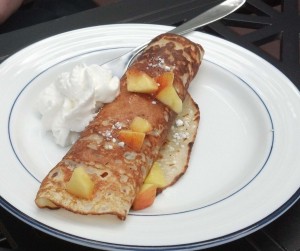
Makes Fifteen to Twenty 6-inch Crêpes
The Crêpe recipe is reprinted from my cookbook, Gluten-Free Makeovers (Da Capo Press) where you’ll find more delicious fillings for them.
2 large eggs
¾ cup rice flour
¼ cup tapioca starch/flour
½ teaspoon salt
¼ teaspoon xanthan gum
1 tablespoon sugar (for dessert crepes)
1¼ cups milk, soy milk, or rice milk
1.Whisk together the eggs in a large bowl. In a separate bowl, combine rice flour, tapioca starch, salt, xanthan gum, and sugar, if using. Whisk into the eggs just until moistened. The mixture will be very thick and gloppy.
2. Add the milk, a little at a time, stirring vigorously until the mixture is smooth and the consistency of heavy cream. Cover and chill for up to 24 hours.
3. Lightly oil one or two 6-inch crêpe pans or heavy frying pans and set over medium heat. Pour about 2 tablespoons of the batter into each pan and swirl until the pan is coated. Pour any excess batter back into the bowl. Cook the crêpe until the edges look very dry, about 1 minute. With a sharp knife, loosen the edges of the crêpe. Using fingers, grab the edges and flip the crêpe. Cook another 30 seconds and remove to a platter. Continue until the remaining batter is used, lightly oiling the pans with a paper towel as necessary.
Peach Melba-Style Filling
1 cup seedless raspberry jam
2 tablespoon brandy
6 medium vine-ripened peaches, peeled and coarsely chopped
confectioners’ sugar
1 peach, skin left on, for garnish
Combine jam with brandy. Spread 1 tablespoon of the mixture over the surface of a crêpe. Add a few pieces of cut up peaches. Roll the crêpe. Repeat until all the crêpes are used. Dust with confectioners’ sugar and serve.
Categories: Recipes | Tags: easy quick gluten-free dessert, gluten-free makeover, gluten-free recipes, Gluten-Free. Desserts, Julia Child | 3 Comments »
I envy Northern California for its long growing season, its verdant farms and endless vineyards. But from June to September, Connecticut is in full bloom and I am content to stay close to home, near the local orchards and farms that rival anything I’ve seen in any other part of the US. Our best chefs know that cooking with fresh, local foods can turn ordinary recipes into three-star meals. I’m reminded of that secret when Connecticut’s harvest smiles. I load up on fresh corn, heirloom tomatoes, zucchini, blueberries, raspberries, strawberries, and herbs. I can never have enough!
And just about now, the orchards are bearing fruit – – pears, apples, and peaches. Ah. Peaches. Perhaps my favorite of all the local produce. Nothing else comes close to that juicy, tree-ripened crop. Their faint fruit perfume floats over the back roads as I drive by the local orchards. I buy them by the bushelful. By the time I get home, I’ve devoured a sizable number and my car seat and steering wheel bear the sticky evidence. It’s a race to reach my saturation point before the trees return to their dormant state. So I eat just as many as I possibly can. But I reserve enough to bake a few special treats.
This peach cake is one. Fresh peach slices, fanned out over the buttery cake, turn this into an elegant dessert that bursts with intense flavor. The cake makes the perfect company dessert that fools most into thinking it’s not gluten-free. Perhaps that’s because I started with a great, gluten-filled recipe. This is a makeover from one I saw in Bon Appetit several years ago. It can also be packed and taken to a picnic or a pot luck meal. Don’t tell, but I make this with frozen peaches when the fresh varieties are not available. They beat the hard, unripened fruit that I find in stores throughout the rest of the year. I’ve also used fresh plums. The purple skin makes for an equally beautiful presentation.
3/4 cup all-purpose gluten-free flour blend *
½ cup sorghum Flour
1½ teaspoons baking powder
½ teaspoon xanthan gum
¾ cup plus 3 tablespoons sugar, divided
8 tablespoons (1 stick) unsalted butter or non-dairy buttery spread, at room temperature
1½ teaspoons finely grated orange zest
2 large eggs or egg replacer of choice
1 tablespoon fresh orange juice
4 ripe, but firm peaches halved and each half cut into 4 slices*
¾ teaspoon ground cinnamon for topping
Whipped cream or whipped dairy-free topping
Second Choice: Cascadian Farms or other brand Organic sliced peaches can be used. Thaw fruit before using. Purchase 2, 10-ounce bags and pick the prettiest slices for this cake. Save the rest for another use.
Preheat the oven to 350°F. Lightly oil a 9-inch spring form pan. Combine the flour blend, sorghum flour, baking powder, and xanthan gum in a bowl; set aside.
Beat ¾ cup of the sugar and butter in a mixing bowl until fluffy. Add the dry ingredients and orange zest and beat until crumbly. Add the eggs, one at a time, beating after each addition. Add the orange juice and beat just to incorporate. Spread the batter evenly in the prepared pan.
Arrange the peach slices on top of the batter so that they touch and form concentric circles that cover the batter. Press into the batter lightly. Don’t worry if the slices are not perfect. The cake will partially cover the fruit as it bakes. Combine the remaining 3 tablespoons sugar and the cinnamon and sprinkle over the batter.
Bake 55 to 60 minutes, until golden and a tester inserted into the center comes out clean. Run a knife along the side of the pan to release and remove the side of the pan. Serve slightly warm or at room temperature with whipped cream or dairy-free topping.
* If the blend you use does not contain salt and gum, add ½ teaspoon salt and ½ teaspoon additional xanthan gum to the dry ingredients.
“I used to serve my family Strawberry Cake before I became gluten-free,” said Alice. Any chance you could create one like that?”
I told her I had seen a bunch of recipes. Some used Jell-O and others used real strawberries. What did she have in mind?
“Not the one with Jell-O. Mine was like a white cake with pureed fruit in it,” she told me.
“I know how to make a gluten-free cake and I’m a sucker for strawberries,” I told Alice. I mean, I’ve been known to plan vacations to coincide with the local strawberry crop, I explained. I was eager to give this a try. But, as it turns out, our local crop of berries has gone by and the fresh strawberries come from across the United States or South America this time of year. I ended up using frozen, whole, unsweetened strawberries. They were easier and tastier. The flavor was more concentrated and more consistent. So, you’ll see that my recipe calls for frozen berries. Unless your local berries are in season, I suggest you do the same. Use fresh berries for garnish and even dip a few in chocolate for an added touch.
And use a good gluten-free cake flour blend, one that includes sorghum and cornstarch. Sorghum is light and less grainy than rice flour. Plus it has nutrients and fiber. Cornstarch lightens the texture and adds structure to the cake. If you are able to have corn products, use it in this recipe. Otherwise, tapioca or potato starch are okay, but a distant second. If you can’t tolerate dairy products, Earth Balance products work well.
Now about color. That’s a matter of preference. I’ve seen versions of strawberry cake that are bright red. That’s not from the berries, I’m afraid. Rather, it’s from red food coloring. If you like that stuff and that color, by all means, add a drop or two to the batter. I prefer the subtle pink and don’t really like food dyes.
So, here’s a really, truly completely from-scratch, fresh strawberry cake. No Jell-O, food coloring, or artificial flavors! Using frozen strawberries makes this easy and means you can celebrate strawberry season anytime of the year.
1, 16-ounce bag frozen, unsweetened whole strawberries
1 cup white rice flour, more to dust pans
¾ cup sorghum flour
½ cup cornstarch
4 teaspoons baking powder
1 ¼ teaspoons xanthan gum
½ teaspoon salt
¼ teaspoon baking soda
12 tablespoons unsalted butter (1 1/2 sticks), at room temperature
1 ¾ cup sugar
3 large eggs, room temperature
2 teaspoons vanilla extract
3 tablespoons milk or milk of choice, at room temperature
Preheat oven to 350 degrees F. Lightly oil 2, 8 or 9 inch round pans. Dust with rice flour. Set aside.
Slightly thaw strawberries. Puree in a food processor. Transfer to a mesh strainer and set over a bowl large enough to set the strainer over the opening. Using a rubber spatula, scrape the puree through the strainer, then scrape the underside of the strainer, catching the puree in the bowl. Repeat until just seeds and pulp remain in the strainer. You should have about 1 ¼ to 1 ½ cups of puree. Set aside and discard the seeds and pulp.
Combine rice flour, sorghum flour, cornstarch, baking powder, xanthan gum, salt, and baking soda. Mix well.
In a large mixing bowl, cream the butter and sugar until smooth and fluffy. Add eggs and vanilla and beat at medium speed for 2 minutes. Add dry ingredients and beat to combine. Fold in ¾ cup strawberry puree. (Reserve remainder for frosting.) Add milk and beat until smooth. If you would like a deeper pink color to the batter, add a drop or two of pink or red food coloring here.
Divide the batter evenly among the pans and smooth tops.
Bake for about 23 to 25 minutes or until a toothpick inserted in the center comes out clean. Let cakes cool in pan for 10 minutes then turn out onto wire racks. Let cakes cool completely before frosting.
Strawberry Cream Cheese Frosting
1 (8 ounce) package of low-fat cream cheese, softened
½ stick of butter, softened
½ cup pureed strawberries from above
1 teaspoon vanilla extract
3 to 4 cups confectioners’ sugar
1 tablespoon milk (if needed)
Beat cream cheese and butter together until smooth.
Slowly add the sugar in 1 cup batches until desired sweetness and consistency is achieved.
Stir in puree and vanilla. Add milk slowly if you need a looser consistency.
Frost cake and garnish with sliced or halved fresh strawberries. Refrigerate until ready to serve.
You can also make 24 cupcakes from this recipe.
Categories: Recipes | Tags: cake, dessert, dessert recipes, Gluten-Free. Desserts, recipes, strawberry desserts, summer dessert recipes | 16 Comments »
A letter from a reader sent me scurrying to create an oatmeal cookie.
“I have had celiac for 15 years, I’m excited about all the new products coming out in all these years. But I haven’t found an oatmeal cookie I like. I was wondering if you have a recipe for oatmeal cookies?”
The note sparked memories of my childhood when we would pull down the Quaker Oats cannister from the top shelf of the cupboard and make the recipe on the back of the container. I couldn’t recall the last time I made oatmeal cookies – certainly not since I became gluten-free 36 years ago.
So her suggestion triggered a powerful reaction in me, a hankering to enjoy chewy oatmeal cookies again. But this time, I couldn’t use Quaker Oats or all-purpose flour and my tastebuds hankered for a more updated, mature version of my childhood favorite. Nevertheless, as I creamed the butter and sugar and folded in gluten-free oats with a wooden spoon that had belonged to my mother, I was, once again, standing at the counter in her blue and yellow kitchen. Funny how a hankering evokes such vivid memories – – the days of childhood, the days of old fashion oatmeal cookies, the days before I was gluten-free.
I suspect oatmeal cookies stir up fond associations for all of us. I brought these cookies to a barbecue where the young adults far outnumbered us oldsters. One-by-one, the “kids” in the group sought me out to say, “thank you.” “These are the best cookies I have ever had,” several of them told me. A couple of them (friends of my son who is a celiac) knew they were gluten-free, but no one else suspected.
The recipe was inspired by one on Food.com. It’s a good thing it makes a big batch! They disappear quickly. A key step in this recipe is to let the dried cranberries soak in the eggs and vanilla for 1 hour. So allow a little extra time when preparing these. If you’d like to reduce the fat, replace 4 to 6 tablespoons of butter with the same amount of unsweetened applesauce.
The Best Oatmeal Cookies Ever
Makes 72-84 cookies
3 large eggs, well beaten
1 cup dried cranberries such as Craisin brand
1 teaspoon vanilla extract
1 cup unsalted butter. softened
1 cup lightly-packed light brown sugar
¾ cup white sugar
2 ¾ cups any All-Purpose Gluten-Free Flour Blend*
1 teaspoon cinnamon
2 teaspoons baking soda
2 ¼ cups gluten-free rolled oats (not steel cut or thick cut oats)
3/4 cup chopped toasted walnuts
*Add 1 ½ teaspoons xanthan gum and ½ teaspoon salt if these are not included in your blend.
Combine eggs, cranberries and vanilla and let stand for one hour.
Preheat oven to 350 degrees. Line two or more cookie sheets with parchment. Set aside.
Cream together butter and sugars. Mix flour with cinnamon and baking soda and whisk to combine. Add to butter mixture and mix well. Blend in egg mixture, oats, and chopped walnuts. Dough will be stiff.
Drop by heaping teaspoons onto cookie sheet, or roll into balls and flatten slightly. Bake for 10 to 12 minutes or until lightly browned around the edges. Cool in pan before removing to a serving tray as cookies are quite soft.
These freeze well.
Categories: Recipes | Tags: cookie recipes, Cookies, dessert recipes, gluten free, gluten-free makeover, oatmeal cookies, recipes | 10 Comments »
Using Your Noodle
I’ve always had a love affair with pasta salads. Easily transformed, they take on the flavor of the dressing, the add-ins, the seasonings, the spices. Cilantro, black beans, corn, and pico de gallo allow me to call my salad, “Mexican Fiesta.” Adding chopped pepperoni, black olives, mozzarella cheese, and artichoke hearts turns my dish into “Antipasto Pasta.”
What’s more, I make it up as I go along. If I have feta cheese and Greek dressing that’s gluten free, the salad might be more of a “Greek Goddess” salad. Caesar dressing and anchovies might become my “Hail Caesar Pasta Salad.” You get the picture. Pasta salad is easy, versatile, and delicious. And little tweaks can completely change its ethnic roots.
Perfect Pasta
With all the gluten-free pasta products available, the trick is selecting the best cut for your salad and following a few simple tips to keep the noodles from getting mushy or absorbing all the dressing before it’s served.
For most pasta salads, select a short pasta. Spirals (fussili), elbows, cavatelli, and small shells are great choices as they hold their shape and pull the flavors of the salad into the crevices of the noodles.
Undercook pasta by 3 to 4 minutes or just until the brittleness is gone. It should be chewy, but not crunchy. Drain the pasta and rinse well under cold water. This removes the starch and cools the pasta so that it does not continue cooking. Now the pasta can sit while you prepare the added ingredients.
Pasta salads can be prepared a few hours ahead but don’t toss the ingredients and dressing into the salad until just before serving.
All Grains are Not Created Equal
Gluten-free pasta comes in all matter of grains. Quinoa, corn, rice, and brown rice are the most common. And many are a blend of flours as well. White rice and brown rice pasta do not hold up as well as others. You might want to leave these for hot dishes that are served as soon as they are made. Corn pasta (preferably from Italy) and quinoa pasta are well suited to pasta salads. They do not fall apart or turn mushy and can even stay overnight in the refrigerator without decomposing.
Here’s one of my favorite summer pasta salads. Roasting the vegetables before they are added, produces an intense and vibrant flavor that is both fresh and satisfying.
Quinoa Pasta Salad with Roasted Tomatoes, Orange and Olives
1 (8-ounce) box Ancient Harvest quinoa rotelle pasta (about 2 cups) or other quinoa or corn pasta
6 large plum tomatoes, each cut into 6 to 8 wedges
1 large onion, halved lengthwise, cut into thin wedges
2 tablespoons extra-virgin olive oil
4 cloves garlic, coarsely chopped
Juice and zest of one orange rind, divided
Salt and freshly ground pepper, to taste
Fresh basil, cut into thin strips (about ¼ cup)
½ cup halved, pitted Kalamata olives
½ cup fresh feta cheese crumbles or dairy-free cheese shreds 2 tablespoons orange juice
1 tablespoon olive oil
Cook pasta in a large pot of boiling salted water 6 to 7 minutes or until tender but still firm to bite. Rinse in cool water and drain well. Set aside.
Preheat oven to 450°F. Oil 2 rimmed baking sheets with nonstick spray.
Spread tomato wedges on one sheet and onion wedges on the second sheet.
Combine 2 tablespoons olive oil, garlic and juice and rind of one orange. Drizzle half over vegetables on each sheet. Sprinkle with salt and pepper. Roast in preheated oven until vegetables are very tender and brown around edges, stirring occasionally, about 30 minutes for onions and 45 minutes for tomatoes. Cool slightly. Set aside.
Transfer pasta to a large serving bowl. Add roasted tomato and onion mixtures, basil and olives to pasta. Stir gently. Add cheese, 2 tablespoons orange juice and olive oil. Toss. Add more salt and pepper, to taste.
Categories: Recipes | Tags: gluten free, Memorial Day recipes, Pasta, Pasta Salad, pasta salad recipes, recipes | 4 Comments »
May is Celiac Awareness Month
I am celebrating with cupcakes and I hope you’ll join me. I’ll tell you how in a moment, but first, here’s a little background on why this event has far-reaching implications for all of us.
The World’s Tallest Gluten-Free Cake
Last year I was part of the world’s largest gluten-free cake event along with the American Celiac Disease Alliance (ACDA) and the 1in133.org awareness project. Hundreds of us met in Washington, DC to build the world’s tallest gluten-free cake, bring attention to the number of people with celiac disease and convince the FDA to reopen the process for creating gluten-free regulations.
While Jules Shepard and John Forberger headed the confectionery team, Andrea Levario and I headed to Capitol Hill to manage the legislative front. With our sons, media folks and gluten-free manufacturers in tow, we spoke to Congressional leaders about the importance of gluten-free regulations. We asked them to keep the pressure on the FDA to push the regulations forward.
They Heard Us And We Ate Cake
In the early evening, we gathered at a reception for supporters and Congressional folks. To our delight, the Deputy Commissioner of the FDA, Mike Taylor, attended. In front of hundreds of us, Deputy Commissioner Taylor told the group we would have gluten-free regulations. On August 4, the FDA reopened the comment period for the regulations. The comment period closed on October 3 and the FDA promised to issue these regulations by the end of the third quarter of 2012. The countdown is on.
Calling All Cupcake Builders
This May, as we await the forthcoming regulations, I invite everyone to make cupcakes – – one for every year you have been gluten-free. Take a picture and share it with the community by posting to the ACDA’s Facebook page. Then post to your Facebook page, blog and link back to the ACDA’s page. Vote for your favorite cupcake by “liking” the photos on the Alliance Facebook page. Prizes will be awarded in categories like best presentation; most unique decorations; most years being gluten-free; and kids categories. The winners will receive products and coupons from several gluten-free companies. Get out those whisks and mixing bowls. The more likes we receive the more voices will be heard from our virtual community. Go to 1in133 for guidelines.
Let’s Eat Cupcakes 
This weekend, I made 56 chocolate cupcakes with peanut butter frosting; 36 for me and 19 for my son, Jeremy. That’s a lot of cupcakes. Let me tell you. But, I’ve seen, firsthand, the power of community. When a standard for gluten-free on food packaging comes out, I can say I had a hand in making it happen. I hope you’ll join me in that effort. It feels good. And, besides, you get to eat cupcakes!
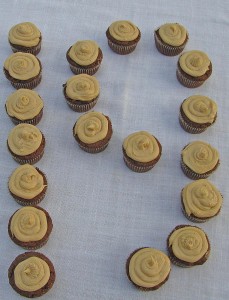 Here’s the recipe I used. You are welcome to “borrow” it. The chocolate cupcakes are a variation on those in my book, Gluten-Free Makeovers. The frosting is pure decadence – – a blend of peanut butter and cream cheese. I love peanut butter and chocolate and the slightly tangy cream cheese flavor cuts the sweetness in a lovely, subtle way. To bring it all together, I top these cupcakes with crushed Reese Peanut Butter Cups. If you are allergic to peanut butter, you could use sunflower butter or simply frost these with plain cream cheese frosting.
Here’s the recipe I used. You are welcome to “borrow” it. The chocolate cupcakes are a variation on those in my book, Gluten-Free Makeovers. The frosting is pure decadence – – a blend of peanut butter and cream cheese. I love peanut butter and chocolate and the slightly tangy cream cheese flavor cuts the sweetness in a lovely, subtle way. To bring it all together, I top these cupcakes with crushed Reese Peanut Butter Cups. If you are allergic to peanut butter, you could use sunflower butter or simply frost these with plain cream cheese frosting.
CHOCOLATE PEANUT BUTTER BLOSSOM CUPCAKES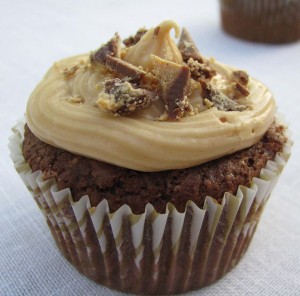
Makes 24 to 28 cupcakes
2 ¼ cups Cake and Pastry Flour
½ cup unsweetened cocoa
2 ½ teaspoons baking powder
½ teaspoon baking soda
1½ cups granulated sugar
12 tablespoons (1½ sticks) unsalted butter or non-dairy buttery spread, at room temperature
3 large eggs, at room temperature
1½ teaspoons vanilla extract
1 cup milk, soy milk, or rice milk
Preheat the oven to 375°F. Lightly grease or oil two 12-cup muffin tins or line with paper liners. Combine the cake flour, cocoa, baking powder; and baking soda. Set aside.
In a separate bowl, beat the sugar and butter until light and fluffy. Add the eggs one at a time, beating to incorporate. Blend in the vanilla. Add the flour mixture alternately with the milk in 3 batches, beginning and ending with the dry ingredients and mixing until each addition is just incorporated.
Spoon the batter evenly into the muffin cups, filling a little more than half full. Smooth the tops and bake on the center rack for 16 to 18 minutes, until a wooden toothpick inserted in the center comes out clean. Let cool in the pans on a wire rack for 10 minutes. Remove from the pans and cool completely before frosting.
PEANUT BUTTER BLOSSOM FROSTING
1 cup smooth peanut butter (any gluten-free brand)
½ cup milk
4 ounces low-fat cream cheese
1 tablespoon vanilla
3 cups confectioners’ sugar
½ cup (about 6) Reese’s Peanut Butter Cups, crumbled (optional)
Beat the peanut butter, milk, cream cheese, vanilla, and sugar together until smooth and fluffy. Frost cupcakes. Sprinkle with crumbled peanut butter cups. Refrigerate until time to serve.
Cake and Pastry Flour
1 cup sweet white sorghum flour (4 ounces)
1 cup white rice flour (5.4 ounces)
¾ cup cornstarch (3.4 ounces)
1½ teaspoons xanthan gum (or guar gum)
½ teaspoon salt
SHORTCUT: This blend makes very light pastries and cookies with a fine crumb but, if you are pressed for time, you may use 2 ½ cups of any all purpose flour blend. Add the xanthan gum and salt if they are not already in the blend.
Categories: Recipes | Tags: 1in133, celiac awareness, chocolate and peanut butter, cupcakes, gluten free, gluten-free makeover, Gluten-Free. Desserts, recipes | 8 Comments »


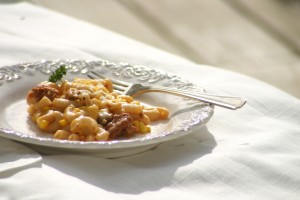

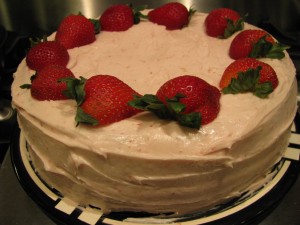





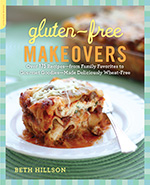
 Baking guru,
Baking guru,